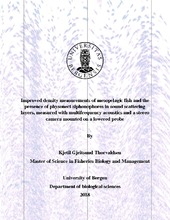| dc.contributor.author | Thorvaldsen, Kjetil Gjeitsund | |
| dc.date.accessioned | 2018-12-11T15:10:21Z | |
| dc.date.available | 2018-12-11T15:10:21Z | |
| dc.date.issued | 2018-12-11 | |
| dc.date.submitted | 2018-12-10T23:00:06Z | |
| dc.identifier.uri | https://hdl.handle.net/1956/18753 | |
| dc.description.abstract | The mesopelagic layer is a massive layer of biomass which stretches from 200-1000 meters depth in almost all locations of the world oceans. These layers are inhabited by many groups of animals, from small zooplankton to larger fishes. While studied since the 1960s, the mesopelagic layer has gained recent scientific and industrial interest due to its potentially large unexploited biomass. These layers are populated by small fishes, which may be ensonified and detected by echo sounders, creating a layer of reverberation called the deep scattering layer. In Norwegian waters, two of the most abundant mesopelagic fishes are the Glacier Lanternfish (Benthosema. Glaciale), and the Muellers pearlside (Maurolicus Muelleri). Recent estimates using echo sounders, suggest that their potential biomass could be as high as 10 billion tonnes worldwide. There are however several challenges with respect to quantifying mesopelagic fishes in an accurate manner. Unwanted swimbladder resonance, other animals with similar echoes, and fishes without or changing swimbladder may potentially create large biases in these investigations. Very low catchability in modern trawls may also complicate the measurements. In this study mesopelagic fishes were measured both with traditional survey methods using vessel mounted transducers, and a lowered acoustic probe where the fishes were measured at short range at their natural depths. It was discovered that the biomass measured were lower with the lowered probe than with the traditional method, but in the same order of magnitude, from 0.01-0.09 fish/m^3. The difference was found was mainly due to the difference between target strength taken from literature, and the directly measured target strength from the probe. Camera observations of physonect siphonophores in the observation volume, may suggest that the biomass of fish measured is even lower. Observation and comparison of the difference in backscattering between 38 and 70 kHz, with higher backscattering at 70 kHz, may suggest that siphonophores are close to resonant at 70 kHz in our data. This gives hope for future classification of this group, especially if wideband are used. In this manner, this study shed light on some of these possible shortcomings and challenges for traditional ways to measure these fishes, but also suggest new methods for solving some of the more important questions. | en_US |
| dc.language.iso | eng | eng |
| dc.publisher | The University of Bergen | en_US |
| dc.subject | Mesopelagic fishes | eng |
| dc.subject | Siphonophores | eng |
| dc.subject | Acoustics | eng |
| dc.subject | Target strength | eng |
| dc.subject | Resonance | eng |
| dc.subject | Swimbladders | eng |
| dc.subject | Pneumatophores | eng |
| dc.subject | vessel acoustics | eng |
| dc.subject | Probe acoustics | eng |
| dc.subject | Muellers pearlside | eng |
| dc.subject | Glacier lanternfish | eng |
| dc.subject | Mesopelagialsonen | nob |
| dc.subject | Fiskebestander | nob |
| dc.subject | Småmaneter | nob |
| dc.subject | Akustiske metoder | nob |
| dc.title | Improved density measurements of mesopelagic fish and the presence of physonect siphonophores in sound scattering layers, measured with multifrequency acoustics and a stereo camera mounted on a lowered probe | en_US |
| dc.type | Master thesis | |
| dc.date.updated | 2018-12-10T23:00:06Z | |
| dc.rights.holder | Copyright the Author. All rights reserved | en_US |
| dc.description.degree | Masteroppgave i biologi | en_US |
| dc.description.localcode | MAMN-BIO | |
| dc.description.localcode | BIO399 | |
| dc.subject.realfagstermer | https://data.ub.uio.no/realfagstermer/c031877 | |
| dc.subject.realfagstermer | https://data.ub.uio.no/realfagstermer/c006550 | |
| dc.subject.realfagstermer | https://data.ub.uio.no/realfagstermer/c004185 | |
| dc.subject.realfagstermer | https://data.ub.uio.no/realfagstermer/c008532 | |
| dc.subject.nus | 751999 | eng |
| fs.subjectcode | BIO399 | |
| fs.unitcode | 12-60-0 | |
